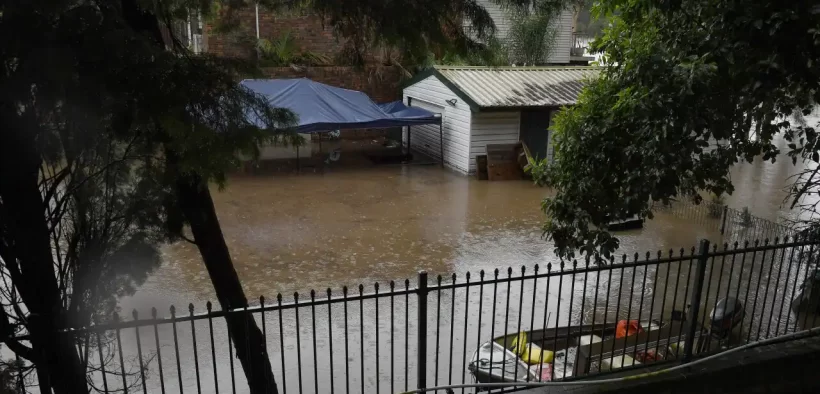Body found in search for delivery driver missing in Sydney floodwaters

Backyards of properties are submerged under floodwater after the Georges River burst its banks in East Hills, south-west of Sydney, Tuesday, 8 March, 2022. Source: AAP / BIANCA DE MARCHI
The driver has been named as Xianbin Liu, 50, from Beverly Hills.

The death toll from the state’s flood crisis is now nine, with the latest fatality coming after the bodies of a man and a woman were found in a western Sydney stormwater canal on Tuesday.
Touring the Northern Rivers region on Wednesday, Prime Minister Scott Morrison described the disaster as “major catastrophe”, more severe than previous flood events Lismore residents have experienced and prepared for.
The prime minister used the trip to announce he would ask Governor-General David Hurley to approve the declaration of a national emergency in NSW and Queensland.
Sydney has had its wettest-ever start to a year after being drenched with average rainfall totals close to what is usually reported in 12 months.
Since January 1, 872mm of rain has fallen in Sydney, the highest tally since records began, eclipsing a previous record of 815.8mm in 1956.
Authorities are warning about widespread disruptions and dangers on the state’s roads, with many closed due to flooding and storm damage, while Sydney Trains also warned of significant disruption and delays.
A sunny day is expected on Thursday, but the state’s flood crisis isn’t over.
Major flooding is continuing, with a number of areas seeing levels worse than in March 2021.
Flood levels are predicted to slowly recede in the coming days as rain eases.
Up to 3139 ADF personnel are expected on the ground by the end of Wednesday, the majority of them in the flood-hit Northern Rivers.

A fifth flood-recovery centre has opened in the region at Casino, joining others already operating at Mullumbimby, Murwillumbah, Kyogle and Lismore.
Grants of $1 million have been extended to declared disaster zones in an additional 28 local government areas, with some 45 councils receiving grants to cover operational costs and restore damaged infrastructure.
NSW small businesses and not-for-profits can apply for up to $50,000 in government support to cover the cost of clean-up and repairs or to restock and reopen.
The federal and NSW government will fund a “bespoke business support package” for northern NSW farmer’s co-op Norco and will work with councils to identify other businesses “critical to the future of the Northern Rivers economy”, Mr Morrison said.
Independent probe into Queensland’s floods announced
There will be an independent probe of southeast Queensland’s devastating floods and the government response, but Premier Annastacia Palaszczuk says it was an “extraordinary unprecedented weather event, the likes of which we’ve never seen before”.
A man is missing and feared dead and another 13 people have died in the deluge, which peaked nine days ago, damaging thousands of homes and businesses from the Wide Bay to the NSW border.
Ms Palaszczuk said the disaster and the government’s response will be independently probed by Disaster Management Queensland.
“That does a complete independent review, as we’ve done with other natural disasters,” she told reporters on Wednesday.
“They get tabled in the parliament at the first opportunity, so of course that will happen.”
There have been questions on flood mitigation releases from Wivenhoe Dam during the intense rainfall, which topped one metre in three days at more than 30 locations across the southeast.
The government denied the Wivenhoe releases increased flooding on the Brisbane River and said the dam was operated in accordance with the manual.
Ms Palaszczuk said water couldn’t have been released when the dam was at 58.7 per cent before the intense rain, which hit the whole southeast and not just the Brisbane River catchment.
“The public clearly understands this: the Wivenhoe (Dam) held back four Sydney Harbours,” she stressed.
“There was so much rainfall … I had people stopping me and Gympie saying, ‘Mate, we’ve never seen rainfall like this in our whole entire lives’.
“So the public understand it. I’ve been very thorough about this and there will be a thorough review. It is independent and it gets tabled in the Queensland parliament.”
Seventeen Queensland local governments have declared disasters and Prime Minister Scott Morrison will meet with the premier on Thursday to discuss declaring the floods as a national emergency, which would streamline Commonwealth support.
As the cleanup continues, the state government will also waive waste levees on all flood refuse in Fraser Coast, Gympie, Noosa, Moreton Bay, Brisbane, Logan, the Gold Coast, Ipswich, the Lockyer Valley, Somerset, Toowoomba and North Burnett.
Meanwhile, the Bureau of Meteorology warned there could be further severe thunderstorms across the southeast on Wednesday afternoon, which could dump intense rain and trigger further flash flooding.
The death toll rose on Monday after police found the body of a man in a car in the Condamine River, southwest of Brisbane.
Another man is still missing after falling from a boat at Bulimba on Brisbane River on 26 February.
A total of 1797 homes were severely damaged and another 2534 moderately damaged by the floods.
Deputy Premier Steven Miles said unlike the 2011 floods a lot of damage was caused by flash flooding, so each area would need to be assessed with tailored flood mitigation.
He said levees, stormwater or back flow drainage upgrades, allowing for higher home rebuilds and home buybacks were options.
Mr Miles also said the state had applied for funding for 20 projects, including an update of its flood warning system, from the Commonwealth’s $5 billion flood mitigation program, but it had only received grants for three projects outside southeast.
“In the meantime, they have made $850 million of interest off that fund,” he said.
“They are making a profit off funds that they have not spent making Queensland more resilient.”











